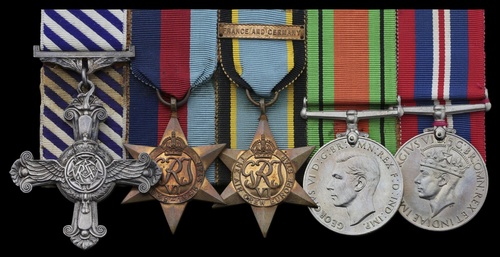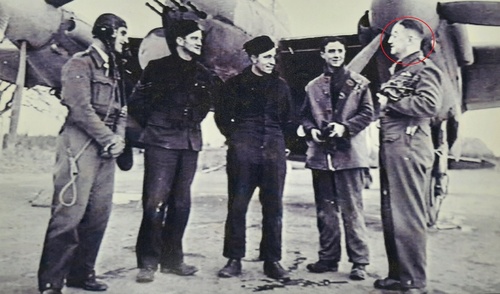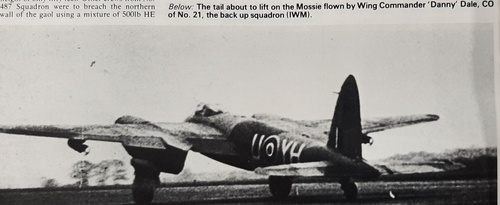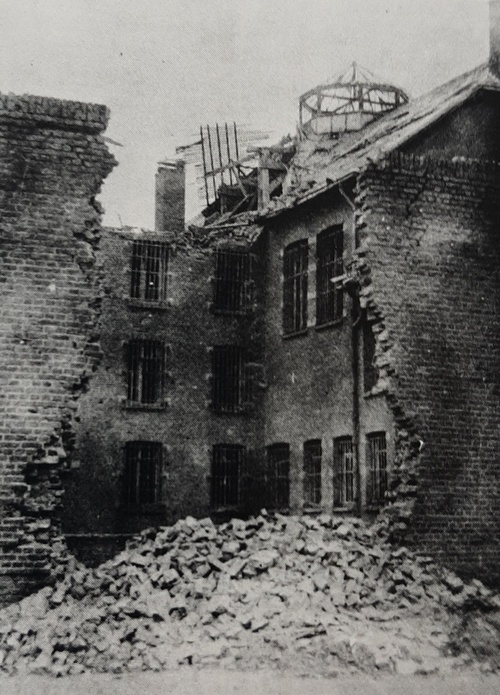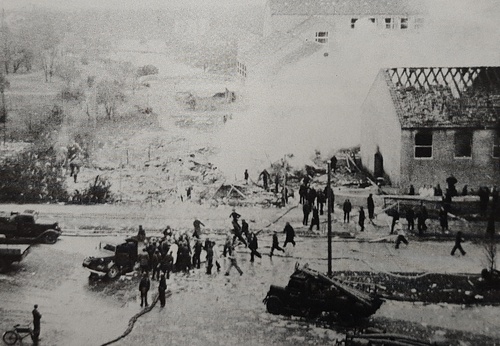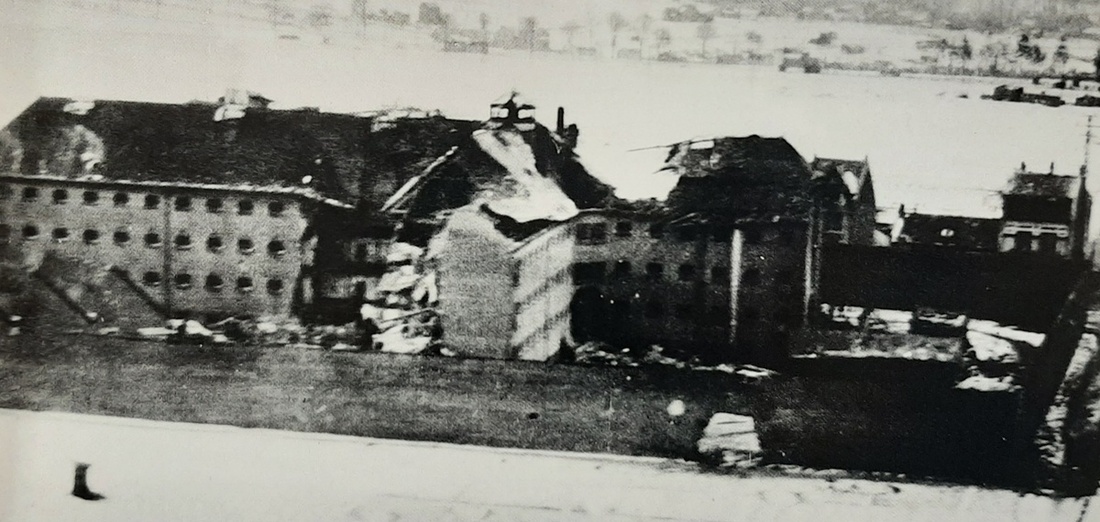Auction: 22003 - Orders, Decorations and Medals
Lot: 482
The 'Operation Jericho 1944' D.F.C. group of five awarded to Wing Commander I. G. E. Dale, No. 21 (Mosquito) Squadron, 'The Grand Old Man of Hundson' who began his Second World War with sorties over the Dunkirk Basin; he was Commander of the force from No. 21 Squadron to take part in the famed attack on Amiens Prison, when the attack went in at tree-top height - 10 feet to be precise - an astonished witness breaking radio silence to exclaim “Bloody hell! From here it looked like the buggers were going to land!”
He later flew on another dangerous low-level strike on the Aarhus Gestapo Headquarters before being killed in action on 2 February 1945
Distinguished Flying Cross, G.VI.R., the reverse officialy dated '1944' and additionally engraved 'W/C I. G. E. Dale, 21 Sqn', in its fitted Royal Mint case of issue; 1939-45 Star; Air Crew Europe Star, clasp, France and Germany; Defence and War Medals 1939-45, with named and addressed O.H.M.S. box, extremely fine (5)
Provenance:
Spink, December 1992.
D.F.C. London Gazette 11 August 1944, the original recommendation states:
'Wing Commander Dale began his present tour of operations in February 1943, and has now completed some 42 sorties. His first were against targets at Dunkirk, where he had to belly-land, wounded, owing to severe flak damage. He then completed 9 operations with 464 Squadron, leading a flight of Venturas. These bombing sorties included Cherbourg Docks, rail centres and factories in France and Holland, with most successful results.
On 2nd February 1944, he took over command of 21 Squadron and is still holding this post. His sorties in Mosquitos included low and high level attacks against Noballs, factories, power stations and aerodromes. He has made intruder trips to Holland and Germany, and participated in the successful Amiens Jail-break. On 6th February 1944, though hit by flak on the way into France, he continued to the target and carried out his attack.
For the last month, Dale has led his Squadron in night-intruder and daylight "Oboe" operations with increasing success. Eager for closer and more frequent contact with the enemy, he has infused his aircrews with an infectious enthusiasm. This, combined with his experience and steady skill has worked wonders with his Squadron, and their present fighting efficiency, initiative and devotion to duty, and at the age of 38 he is one of the keenest operational pilots in the Group.'
Ivor Gordon Easton Dale - or Daddy to his friends and comrades - was born at Caterham Valley, Surrey in April 1905, the son of Horace and Francis Dale of The Retreat, Kent. Joining the Royal Air Force in 1925 as a Pilot under Instruction he was promoted Flying Officer on 31 October 1926. Promoted Flight Lieutenant in 1931 he served with Middle East Command with No. 14 and 46 Squadron. Sent to the Reserve on 16 November 1934, he wasserving at No. 3 and 5 Training Schools, Central Flying School.
No. 464 - into the fire
Promoted Squadron Leader while still with the Reserve, he was posted to No. 464 Squadron, Royal Australian Air Force, flying Venturas on 31 December 1942. In his first sortie Dale had a close brush with death while leading 'B' Flight in an attack on a 5,000 ton merchant raider in the Dunkirk Basin. Under heavy fire from the ground both he and his navigator were hit by splinters but despite the damage Dale was able to coax his damaged machine back to base. Here he had a nasty surprise, not only had the flak damaged the landing gear, forcing him into a 'belly landing' but two of his bombs had failed to release and were still beneath the aircraft when he landed. Continuing to fly, he saw a total of 19 Ops with this Squadron before transferring to assume command of No. 21 (Mosquito) Squadron on 1 February 1944.
No. 21 Squadron - C.O.
Promoted Wing Commander, Dale began flying with No. 21 Squadron from 3 February 1944 in a mission over Beaumont Le Harong. Four more followed in quick succession, with Dale being hit in the port engine over Bois Coqerie on 6 February - the targets were mostly construction works. However their capacity for low-level bombing missions soon led them to another assignment.
Operation Jericho - The Amiens Prison Jailbreak
Dale's No. 21 Squadron were ordered to fly as the reserve force on Operation Jericho, the raid on Amiens Prison, intended to spring over 100 French Resistance fighters from captivity. The plan was to hole the wall, giving the prisoners a chance to escape. As commander of the third wave Dale was heavily involved in the planning of this raid and was on hand with a wry comment And the Walls Came Tumbling Down refers:
'Briefing of the rest of the crews was set for early next morning, until "Jock" Cumings; evening weather report came in. There wasn't a hope in heaven of take-off yet.
"We nearly always seem to get the roughest Ops on Sundays - probably because so many of us don't go to Church regularly", said "Daddy" Dale, "so I bet it will be Sunday"
There were no takers.
It turned out to be a Friday.'
Nevertheless even he struggled to stomach the knowledge of his Squadron's role in the attack. When Pickering had dropped his bombs he would circle and try to ascertain whether the escape was successful. If it was not then No. 21 Squadron would circle back around and bomb the prison itself: the prisoners had communicated their desire to die in a bombing than by German bullets. Group-Captain Pickering led the attack personally while Dale led the six Mosquitos from No. 21 Squadron. The first wave was to destroy the walls and the second would target the prison itself as well as hitting the garrison quarters. No. 21 Squadron formed the final wave, a reserve that could move to cover any area that needed support.
The formation lost four aircraft - including two from No. 21 Squadron - in the poor weather crossing the channel. Those who remained pressed on with Typhoon support towards the target. As they approached F.W.109s shadowed them from the cloud cover and then dived into the attack. Despite this the strike force pushed through and hammered the target, successfully breaching both prison and wall. No. 21 Squadron in their role as the reserve were the first away.
Of the 700 Resistance prisoners incarcerated in the prison, around 260 escaped through the breached walls, but another 100 or so were killed during the course of the bombing, or by the fire of German guards. But such risks were always apparent and did nothing to detract from the extraordinary bravery displayed by the attacking force’s pilots and navigators. As one participant put it:
'This was the sort of operation that gave you the feeling that if you did nothing else in the war, you had done something.'
In 1946, prompted by the fact that Operation 'Jericho' was undoubtedly one of the most dramatic stories of the War, Sacha Cordine directed a film about the raid, many of the 'actors' actually being members of 138 Wing.
Aarhus Raid
Dale remained with No. 21 Squadron for another 35 sorties before being posted away in July 1944. However he returned in September - again as C.O. - and was soon called in for service in the Aarhus Operation. British intelligence had received a signal from the Danish Resistance stating:
'Underground in Jutland about to be torn up by Gestapo. It is more important to destroy archives and save our people than to save archives and have our people destroyed. I beg forcibly that colleges four and five be destroyed by air attack. They are the two most westerly buildings in the University block. Urgent.'
Taking off from Thorney Island on 31 October 1944 the attacking force - again drawn from three squadrons - included No. 21. flying at very low level over the sea the raid began just four minutes after the alarm was raised. While the fighter escort of Mustangs strafed the ground defences, the Mosquitos began their pin-point bombing. Both Colleges 4 and 5 were totally destroyed whilst the rest were seriously damaged, although due to their stronger concrete structures they were intact. German losses were estimated around 150, with a great many members of the Gestapo among them. The files on the Danish Resistance cells were totally destroyed, saving countless lives. Alongside this, the Resistance launched a raid of their own, using the air attack as a cover they freed as many prisoners as they could.
Journey's end
Still commanding No. 21 Squadron, Dale flew at the head of his unit through the end of 1944 and the early weeks of 1945. They struck at enemy railways and moving columns, interrupting the flow of supplies to the withdrawing German forces. Stationed in North Holland Dale went up with his unit on 2 February 1945 only to be hit while over the target. He was last heard over the radio stating that he was bailing out; both he and his Navigator where killed and are buried at Sittard War Cemetery; sold together with an original photograph and R.A.F. cloth 'wings', along with the book And the Walls Came Tumbling Down as well as copied research including Commonwealth War Graves details, service papers and recommendation for award as well as after-action reports, extracts from After the Battle and articles from the R.A.F. history website along with former auction listings.
Subject to 20% VAT on Buyer’s Premium. For more information please view Terms and Conditions for Buyers.
Sold for
£5,200
Starting price
£1200

